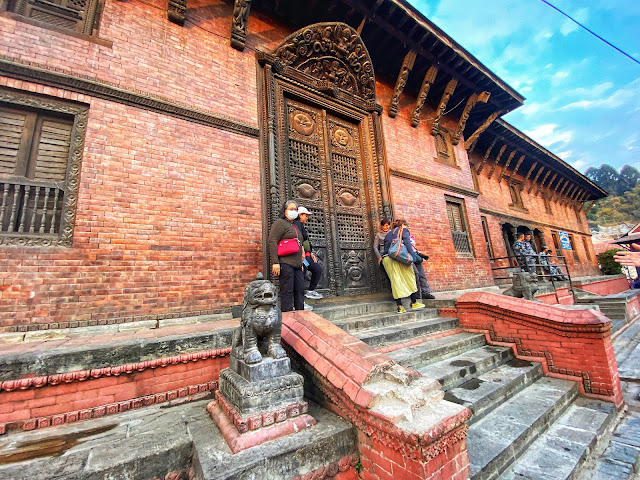Pashupatinath Temple is the oldest Hindu temple in Kathmandu. It is not known for certain when Pashupatinath Temple was built. But according to Nepal Mahatmaya and Himvatkhanda,the deity here gained great fame there as Pashupati. Pashupatinath Temple's existence is recorded as early as 400 CE.The ornamented pagoda houses the linga of Shiva. There are many legends describing how the temple of Aalok Pashupatinath came into existence here.
Pashupatinath Temple
วัดปศุปฏินาถ (เนปาล: पशुपतिनाथ मन्दिर) เป็นวัดฮินดูที่อุทิศให้กับพระปศุปตี ซึ่งเป็นรูปแบบหนึ่งของพระศิวะ ตั้งอยู่ในกาฐมาณฑุ ประเทศเนปาล ใกล้กับแม่น้ำบักมาติ วัดนี้ได้รับการจัดให้เป็นมรดกโลกในปี พ.ศ. 2522ในฐานะเป็นหนึ่งในเจ็ดอนุสรณ์สถานแห่งหุบเขากาฐมาณฑุ
The temple courtyard has four entrances in the cardinal directions. The western entrance is the main entrance to the temple courtyard and the remaining three entrances are open only during festivals. The temple security (Armed Police Force Nepal) and the Pashupatinath area development trust are selective regarding who is allowed entry into the inner courtyard. Practising Hindus of South Asian diaspora and Buddhists of Nepali and Tibetan diaspora are only allowed into the temple courtyard. Practising Hindus of Western descent are not allowed into the temple complex and must go no further than other non-Hindu visitors. An exception is granted to Sikhs and Jains: if they are of Indian ancestry they may enter the temple complex. Others can look at the main temple from the adjacent side of the river[10] and pay $10 (1,000 Nepali rupees) to visit the small temples located in the external premises of the temple complex
One legend says that Shiva and Parvati took the form of antelopes in the forest on the Bagmati river's east bank. The gods later caught up with him and grabbed him by one of his horns, forcing him to resume his divine form. The broken horn was worshipped as a linga, but over time it was buried and lost. Centuries later a herdsman found one of his cows showering the earth with milk, and after digging at the site, he discovered the divine linga of Pashupatinath.
ตำนานหนึ่งเล่าว่าพระอิศวรและปาราวตีได้แปลงร่างเป็นละมั่งและอาศัยอยู่ในป่าบนฝั่งตะวันออกของแม่น้ำบักมาติ ในเวลาต่อมาเหล่าเทพก็จับเขาด้วยเขาข้างหนึ่งของเขา บังคับให้เขากลับคืนร่างอันศักดิ์สิทธิ์อีกครั้ง เขาที่หักนั้นถูกบูชาเหมือนองคชาติ แต่เมื่อเวลาผ่านไปมันก็ถูกฝังและสูญหายไป หลายศตวรรษต่อมา คนเลี้ยงสัตว์พบว่าวัวตัวหนึ่งของเขาได้หลั่งน้ำนมลงบนพื้นแห่งหนึ่ง และหลังจากขุดที่บริเวณนั้น เขาก็ค้นพบองคชาติศักดิ์สิทธิ์ของปศุปฏินาถ
วัดปศุปฏินาถเป็นวัดฮินดูที่เก่าแก่ที่สุดในกาฐมา ณ ฑุ วัดปศุปฏินาถสร้างขึ้นเมื่อใดไม่ทราบแน่ชัด แต่ตามคำกล่าวของมหาตมะยาและหิมวัตคันดาของเนปาล เทพเจ้าที่นี่มีชื่อเสียงโด่งดังที่นั่นในนามปศุปติ การดำรงอยู่ของวัดปศุปฏินาถได้รับการบันทึกตั้งแต่ช่วงคริสตศักราช 400[4] เจดีย์ประดับประดาเป็นที่ประดิษฐานพระศิวะ มีตำนานมากมายที่เล่าว่าวิหารของอาโลกปศุปฏินาถเกิดขึ้นที่นี่ได้อย่างไรวัดหลักแห่งนี้สร้างขึ้นในสถาปัตยกรรมสไตล์เจดีย์เนปาล หลังคาสองชั้นเป็นทองแดงปิดทอง วัดตั้งอยู่บนแท่นฐานสี่เหลี่ยมจัตุรัส สูง 23 ม. 7 ซม. จากฐานถึงยอด มีประตูหลักสี่บาน ปูด้วยแผ่นเงินทั้งหมด วัดนี้มียอดทอง ข้างในมีการ์ภกริหะสองแห่ง: การ์ภกริหะภายในหรือห้องศักดิ์สิทธิ์เป็นที่ที่เทวรูปตั้งอยู่ และห้องศักดิ์สิทธิ์ด้านนอกเป็นพื้นที่ทางเดินที่เปิดโล่งIn the Hindu religion, cremating the body after death by a holy river will assure that all your sins are purged and you’ll be sent to Nirvana in the afterlife. The Bagmati River, which is seen as holy to both Hindus and Buddhists, runs straight through this temple and so this is the holy river that is used for cremations.
ในศาสนาฮินดู การเผาศพหลังความตายด้วยแม่น้ำศักดิ์สิทธิ์จะช่วยให้มั่นใจได้ว่าบาปทั้งหมดของคุณจะได้รับการชำระล้าง และคุณจะถูกส่งไปสู่พระนิพพานในชีวิตหลังความตาย
โดยปกติแล้วศพจะถูกคลุมด้วยการแสดงใบหน้าเพื่อให้คนที่รัก (โดยปกติจะเป็นผู้หญิง) กล่าวคำอำลาและตักข้าวใส่ปาก จากนั้นนำศพไปล้างในแม่น้ำและเตรียมเผาโดยชายคนโตของครอบครัว จากนั้นศพจะถูกเผาบนเมรุ และขี้เถ้าจะถูกส่งลงแม่น้ำศักดิ์สิทธิ์
Why do Hindu’s openly cremate bodies and what’s the process?
In the Hindu religion, cremating the body after death by a holy river will assure that all your sins are purged and you’ll be sent to Nirvana in the afterlife. The Bagmati River, which is seen as holy to both Hindus and Buddhists, runs straight through this temple and so this is the holy river that is used for cremations. What caste (Hindu status/class) you are, depends on where you are cremated. You will see podiums all the way down the river.
In the Hindu religion, cremating the body after death by a holy river will assure that all your sins are purged and you’ll be sent to Nirvana in the afterlife. The Bagmati River, which is seen as holy to both Hindus and Buddhists, runs straight through this temple and so this is the holy river that is used for cremations. What caste (Hindu status/class) you are, depends on where you are cremated. You will see podiums all the way down the river.






















ไม่มีความคิดเห็น:
แสดงความคิดเห็น